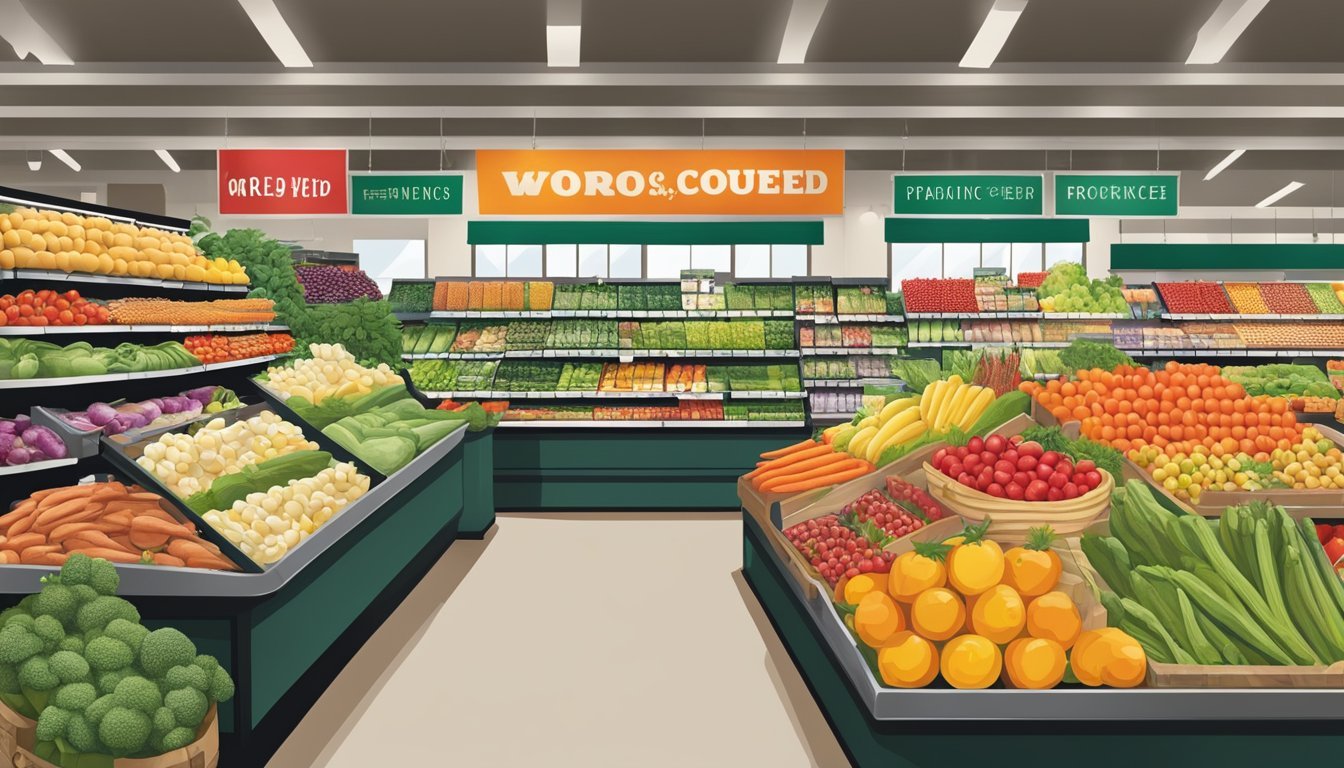Whole Foods Market vs Hy-Vee
Comparing Shopping Experience, Quality, and Prices
Part of Our Grocery Store Guide with Details on Whole Foods Market Prices and Hy-Vee Prices
When choosing a grocery store, shoppers weigh various factors such as product quality, prices, and store services. Whole Foods Market and Hy-Vee are two prominent players in the grocery retail space, each with their own set of strengths that cater to different consumer preferences. Whole Foods is known for its wide range of organic and natural foods, often associated with higher quality standards. The brand targets health-conscious consumers, offering a selection of goods that aligns with a clean-eating lifestyle.
Hy-Vee, on the other hand, has built a reputation in the Midwest for its commitment to customer service and competitive prices. It provides a broad selection of products that include specialty foods, health-focused options, and conventional grocery items. Both grocery stores have carved out distinct identities and have loyal customer bases, which makes comparing them an interesting endeavor.
These stores' positioning strategies reflect their core customer values and priorities. Whole Foods Market prioritizes environmental sustainability and health-centric products, aligning itself with consumers who value those aspects in their shopping experience. Conversely, Hy-Vee emphasizes customer value and convenience, appealing to those looking for a one-stop shop for quality groceries at reasonable prices. The discussion of which store is better is not a matter of superiority but rather of suitability to individual consumer needs and preferences.
Company Backgrounds
The history of both Whole Foods Market and Hy-Vee traces back to humble beginnings and reveals each company's growth into prominent grocery retailers in America. Each has its own unique heritage and expansion story, which contributed to their respected standings in the U.S. market today.
History of Whole Foods Market
Founded: 1980
Founders: John Mackey, Renee Lawson Hardy, Craig Weller, and Mike Skiles
Headquarters: Austin, Texas, U.S.
Whole Foods Market began as a small natural foods store in Austin, Texas. John Mackey and his co-founders transformed this store into a supermarket chain specializing in organic products. Their commitment to quality and environmentally conscious practices led to a rapid expansion. In 2017, Amazon acquired Whole Foods Market, bringing technological innovation and a broader customer base to the brand. As of 2024, Whole Foods has established itself as a household name across North America and the United Kingdom.
History of Hy-Vee
Founded: 1930
Founders: Charles Hyde and David Vredenburg
Headquarters: West Des Moines, Iowa, U.S.
Hy-Vee's story started in a small brick building in Beaconsfield, Iowa, where its founders opened the doors with a vision to provide superior customer service, a wide range of products, and affordable prices. The name Hy-Vee is a contraction of its founders' last names, Hyde and Vredenburg. Over the years, Hy-Vee has grown into a significant player in the Midwestern grocery sector, known for its employee ownership model. The company upholds the founders' original philosophy to this day, operating over 240 stores across the Midwest region of the United States.
Store Networks
The physical presence and distribution of stores are critical for any supermarket chain's success. These networks determine the accessibility and convenience for consumers in different regions.
Whole Foods Market Locations
Whole Foods Market, recognized for its organic and natural products, operates predominantly in the United States with over 500 stores across North America and the United Kingdom. It has a strong footprint in major metropolitan areas, catering to urban shoppers who prioritize health-conscious products. The chain is also known for its commitment to high-quality and sustainable offerings.
Regions: Primarily urban regions across the U.S., with stores also in Canada and the UK.
Store Brands: 365 by Whole Foods Market, Whole Foods Market, Whole Paws, and Whole Catch.
Hy-Vee Locations
Hy-Vee is a regional supermarket chain with a significant presence in the Midwestern United States. With fewer stores than Whole Foods, roughly 280 locations, Hy-Vee focuses on providing a varied assortment, including health market sections within their stores. The brand is known for its innovative approaches to retail, including different store formats and services.
Regions: Concentrated in the Midwest; examples include Illinois, Iowa, Kansas, and Nebraska.
Store Brands: Hy-Vee offers several store brands such as Hy-Vee Aisles Online, Hy-Vee Mealtime to Go, and Hy-Vee Deals.
The networks of both Whole Foods and Hy-Vee reveal their strategies and regional focuses with Whole Foods targeting nationwide urban centers and Hy-Vee concentrating on regional Midwestern markets.
Product Range Comparison
When comparing Whole Foods Market and Hy-Vee in terms of product range, shoppers will find differences in quality of produce, organic and health options, store brand products, and prepared foods variety. Each store caters to distinctive consumer needs and preferences.
Quality of Produce
Whole Foods Market is renowned for its high-quality fruit and vegetables. The company commits to offering a range of fresh produce, emphasizing the quality and aesthetic appeal. Hy-Vee also provides a variety of fruit and veggies, but customer perceptions sometimes indicate a slightly varying level of freshness and quality compared to Whole Foods Market.
Organic and Health Options
Whole Foods Market excels with a vast selection of organic produce and healthy food choices, living up to its reputation as a leader in organic and natural foods. Hy-Vee counters with a respectable organic section, though it may not match the breadth of Whole Foods Market's offerings.
Store Brand Products
Whole Foods Market has its "365" brand, offering a wide range of products that promise quality at a more affordable price point. These include pantry staples, dairy, and frozen foods.
Hy-Vee also offers store brand products that tend to be competitively priced. They focus on providing similar quality as national brands at budget-conscious prices, including their own line of sliced cheeses and sour cream which are popular among consumers.
Prepared Foods Variety
Whole Foods Market is known for its extensive prepared foods section with options ranging from salads and sushi to hot meals. They cater to various dietary preferences including vegan and gluten-free diets. Hy-Vee's prepared foods counter offers a diverse selection, including ready-to-eat meals that are quick and convenient for shoppers looking for on-the-go options.
Price Analysis
In analyzing Whole Foods Market versus Hy-Vee, the examination of pricing focuses on the affordability of essential items, the cost of organic products, and a general comparison of overall store prices.
Affordability of Essentials
Whole Foods Market is typically associated with higher prices for essentials when compared to Hy-Vee. Essentials like milk, bread, and eggs often exhibit a price premium at Whole Foods due to their focus on organic and higher-quality options. For example, a gallon of organic milk might cost significantly more at Whole Foods than the conventional milk at Hy-Vee.
Comparative prices for common items:
Milk: Whole Foods ($3.99) vs. Hy-Vee ($2.49)
Bread: Whole Foods ($4.00) vs. Hy-Vee ($1.50)
Eggs: Whole Foods ($4.99/dozen) vs. Hy-Vee ($1.99/dozen)
Pricing of Organic Products
When it comes to organic products, Whole Foods Market often has a greater selection, which can lead to more competitive prices for these items. However, Hy-Vee also offers a range of organic options, often under a store brand that can provide savings over name-brand organic products. Price scales for organic foods typically tip in favor of Whole Foods due to their extensive organic focus.
Organic product prices per pound might look like:
Apples: Whole Foods ($1.99/lb) vs. Hy-Vee ($2.29/lb)
Chicken: Whole Foods ($6.99/lb) vs. Hy-Vee ($7.49/lb)
Comparison of Overall Prices
Based on a general overview, Whole Foods Market's overall prices are higher than those at Hy-Vee. This discrepancy is influenced by Whole Foods' emphasis on organic, non-GMO, and sustainably sourced products, which come with a higher price tag. However, for shoppers prioritizing those attributes, this cost difference might be justified. Hy-Vee, while offering a variety of quality options, is more affordable, especially for generic staples.
When comparing overall prices, consider the following:
Essentials at Hy-Vee tend to be more affordable than at Whole Foods Market.
Both stores carry their own generic brands—365 by Whole Foods Market and Hy-Vee's store brand—which can offer considerable savings. For example, Hy-Vee's generic pasta might cost $1.00, whereas Whole Foods Market's 365-brand alternative could be $1.50.
For customers with a focus on the lowest prices for common items, stores like Walmart, Costco, and Aldi remain strong competitors in the market, often undercutting both Whole Foods and Hy-Vee with their store brands such as Walmart's Great Value.
Despite the higher prices, some shoppers may still prefer Whole Foods Market for its specialty items and commitment to environmental and dietary standards.
Customer Experience
When comparing Whole Foods Market and Hy-Vee, several factors determine the quality of customer experience. These include the service quality, the cleanliness of the store, and the efficiency of the checkout process, each contributing to the overall satisfaction of consumers.
Service Quality
Whole Foods Market prides itself on high service standards, emphasizing knowledgeable staff to assist customers with health-conscious choices. Employees are often available to guide consumers through diverse organic and natural food selections.
In contrast, Hy-Vee is known for a family-friendly atmosphere, integrating the Midwest's values of friendliness and customer service. Trust is a cornerstone, with employees trained to provide warm and supportive interactions.
Store Cleanliness
Cleanliness is paramount for both retailers. Whole Foods Market maintains a spotless environment in line with its premium brand image. Hy-Vee also prioritizes cleanliness, ensuring their stores are tidy, which increases consumer trust and confidence in their grocery retail offerings.
Ease of Checkout
Whole Foods utilizes modern checkout systems, often incorporating self-service options to streamline the process. The layout is designed to reduce bottlenecks, allowing for a quick and hassle-free experience at the point of sale.
Hy-Vee addresses checkout ease by implementing efficient staff-operated registers. Additionally, some locations offer online shopping and curbside pickup, catering to consumers' evolving preference for convenience.
Survey and Consumer Trust
When considering the reputation of grocery retailers, surveys conducted by organizations like BrandSpark and Newsweek provide insight into consumer trust and preferences.
BrandSpark and Newsweek Surveys
BrandSpark International, in partnership with Newsweek, annually conducts comprehensive surveys assessing consumer opinion. In the 2023 survey, 10,082 Americans were queried to determine the grocery store brands they trust the most. These results not only influence the BrandSpark Most Trusted Awards (BMTAs), but also guide consumers in making informed shopping choices.
Most Trusted Grocery Stores
According to the findings released by BrandSpark and Newsweek, certain grocery retailers stand out for their trustworthiness. For instance, both Whole Foods Market and Hy-Vee were mentioned among the most trusted grocery stores. This reflects a significant endorsement by consumers, highlighting these brands' commitment to earning and maintaining customer trust.
Whole Foods Market
Hy-Vee
Wegmans
H-E-B Grocery
These brands have consistently resonated with customers, which is reflected in their positions in the survey rankings. Trust factors often include product quality, store cleanliness, and customer service excellence.
Exclusive Brands and Partnerships
When it comes to grocery shopping, exclusive brands and partnerships significantly influence customer preference and loyalty. Whole Foods Market and Hy-Vee have cultivated unique alliances and store brands, distinguishing them in the crowded retail marketplace.
Whole Foods Exclusive Partnerships
Whole Foods Market has established a strong reputation with its line of exclusive store brands. A key standout is its 365 by Whole Foods Market, which offers a wide range of products from organic canned goods to "better-for-you" cleaning supplies and unique items like peanut butter cookie dough ice cream. This flagship brand positions Whole Foods Market as a leader in quality and organic product offerings. They've also engaged in partnerships that align with their health-conscious brand image, ensuring that customers consistently have access to high-quality and healthy prepared foods.
Hy-Vee Brand Alliances
Hy-Vee, on the other hand, has been recognized for its array of brand alliances that cater to varied consumer needs. While not explicitly mentioned in the search results, Hy-Vee's commitment to customer trust and satisfaction has led them to create multiple store concepts, including a convenience store and dollar format. The brand's flexibility and responsiveness to industry and consumer trends show a dedication to innovation and partnerships that keep customers at the center of their retail experience. As per surveys conducted by BrandSpark, consumers have indeed placed their trust in Hy-Vee, likely a reflection of their strategic brand alliances and customer-centric approach.
Convenience and Services
When comparing Whole Foods Market to Hy-Vee, customers will find distinct differences in their convenience and services. Both cater to various needs through grocery delivery options and in-store amenities, providing customers with an array of choices.
Grocery Delivery Options
Whole Foods Market offers delivery services through Amazon Prime, allowing customers to enjoy same-day deliveries in many locations. This service is especially prevalent in urban areas where Whole Foods stores are more common. Customers benefit from the integration with Amazon's extensive delivery network, making it a strong contender for those seeking convenience.
Hy-Vee, on the other hand, has its own grocery delivery service. While it may not have the same reach as Whole Foods, Hy-Vee's strong presence in the Midwest ensures that customers within its service area have access to timely and reliable delivery options.
In-Store Amenities
Whole Foods Market is known for its range of in-store amenities. Customers can find a variety of organic and health-focused products. Store formats include on-site dining options and specialty sections like cheese and wine, adding a layer of sophistication to the shopping experience.
Hy-Vee stores, tailored more towards a practical and family-oriented shopping experience, provide various services such as pharmacies and medical clinics. In some locations, they also feature a dedicated health and specialty section for wellness products.
These two grocery chains offer various options and formats to meet the needs of different customer bases, solidifying their positions as leading grocery providers.
Consumer Loyalty and Perception
The battle for customer loyalty in the grocery sector is fought on numerous fronts, from product selection to customer service. Whole Foods Market and Hy-Vee have unique approaches to earning and maintaining the trust and loyalty of American shoppers.
Regular Shoppers' Opinions
Regular patrons of Whole Foods Market often cite the company’s commitment to high-quality, healthy, and organic products as a cornerstone of their loyalty. These consumers value the store's atmosphere and diverse product range that caters to dietary preferences and ecological concerns. In contrast, Hy-Vee’s commitment to customer service and community involvement has fostered a loyal following, particularly among Midwestern families. The store’s ability to provide a personalized shopping experience remains a significant factor in maintaining its consumer base.
Whole Foods Market: Known for organic and specialty products
Hy-Vee: Praised for customer service and community presence
Market Research Outcomes
Recent surveys and market research shine a light on the perceived trustworthiness of grocery retailers. According to a BrandSpark survey, Whole Foods Market and Hy-Vee rank highly among American shoppers for trust in the category of healthy prepared foods, each securing a place as a trusted brand. Such outcomes reflect the success of each retailer's distinct strategies in building consumer confidence and loyalty.
BrandSpark Survey Highlight:
Whole Foods Market excels in Healthy Prepared Foods
Hy-Vee is also a trusted brand in the same category
By understanding and leveraging these insights, both Whole Foods Market and Hy-Vee continue to cultivate their relationships with shoppers, although they approach this goal through different avenues. Whole Foods emphasizes quality and health-centric values, while Hy-Vee focuses on the customer service experience and its role within the community.
Conclusion
When comparing Whole Foods Market and Hy-Vee, shoppers should consider their priorities regarding price, quality, service, and selection. Whole Foods Market is known for its high-quality organic and natural products, and although prices may be higher, it caters to a demographic seeking premium goods.
Hy-Vee, on the other hand, balances cost and quality more evenly, catering to a broad range of customers. It has a reputation for good customer service and offers a competitive selection of goods at relatively lower prices than Whole Foods Market.
Both grocery stores have loyal customer bases and their own set of strengths:
Whole Foods Market: Renowned for its organic selection and natural products.
Hy-Vee: Respected for strong customer service and varied product offerings.
While each supermarket has divergent approaches to quality and pricing strategies, the choice between Whole Foods Market and Hy-Vee ultimately hinges on individual shopper's values and needs within the grocery store landscape.








